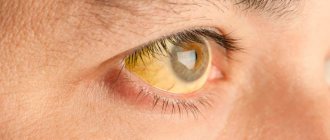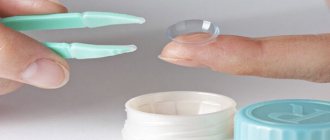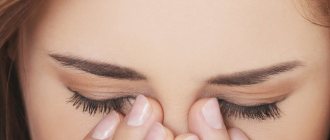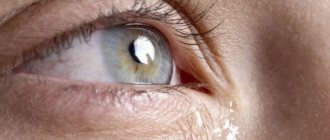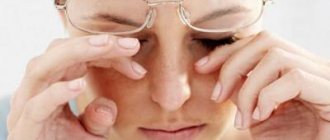Stinging and tearing of the eyes are common, but are rarely due to a serious medical condition. Most often, these symptoms go away without the use of medication. Painful sensations can occur on the surface of the eye or inside it - the orbital form.
Types of pain and tearing
Cutting on the surface accompanied by tears is usually caused by irritation from a foreign object, infection or injury. Often this type of irritation is easily treated with eye drops or rest.
Eye pain accompanied by vision loss may be a sign of a serious illness. If you have these symptoms, contact your ophthalmologist immediately.
Tearfulness is a condition in which the secretion of tears occurs spontaneously for no apparent reason. This often happens due to insufficient outflow of tear fluid, which is released not through the nasolacrimal duct, but through the lacrimal canals. Tears are produced to continually moisturize the ocular surface, thereby maintaining clear vision. However, excessive tearing can impair your ability to have healthy vision. Motorists are especially advised to pay attention to this problem, since driving with tearing can be difficult or dangerous.
Pain with tears can be a problem at any age. It often affects people under 12 months of age or over 60 years of age. May affect one or both eyes. Tearfulness usually responds well to treatment.
Tearfulness in a child
If lacrimation is observed in a newborn baby, the first step is to exclude congenital obstruction of the lacrimal canaliculus and dacryocystitis (inflammation of the lacrimal sac). When the fetus develops in the womb, its tear ducts are delimited by peculiar “gelatin” films. Why is this necessary?
As a rule, this disease is not dangerous; it goes away on its own during the first 6 months of life. If this does not happen, the nasolacrimal duct is probed at the age of 1–2 years. If dacryocystitis occurs with complications (suppuration, phlegmon of the lacrimal sac), then probing is carried out at an early age (2–3 months).
Causes
Among the causes of increased lacrimation, two main ones can be distinguished: obstruction of the lacrimal ducts and increased production of tear fluid.
Blocked tear ducts
Blocked ducts become the most common cause of tearing in adults. This is an acquired condition, but congenital underdevelopment of the lacrimal ducts also occurs. Often, increased tearfulness occurs in newly born babies. This is due to the fact that the ducts may not be sufficiently formed. Tearfulness goes away within two to three weeks.
In adults and adolescents, increased tearing most often occurs due to narrowing of the ducts or when they are blocked. Narrowing of the tear ducts usually occurs as a result of swelling or inflammation. If the ducts are narrowed or blocked, tears will not be able to drain and will accumulate in the lacrimal sac.
Stagnation of fluid and the lack of its dynamics contribute to an increased risk of inflammation and infection. The eye then secretes a sticky secretion, which makes the problem worse. Since the eye and nose are connected by a canal, inflammation can spread to the nose from the side of the affected canal. As a result, the drainage system, which itself is narrow, swells and becomes impassable. Subsequently, swelling, inflammation and further tissue scarring occurs.
Increased production of tear fluid
When there is pain in the eyes, more tear fluid may be produced than necessary. This is due to the fact that the body is trying to get rid of the irritating substance. The following reasons can lead to pain and tearfulness:
- some chemical agents, including gaseous ones;
- food products such as onions;
- conjunctivitis: bacterial, viral, allergic origin;
- mechanical damage or ingress of a foreign body, dust;
- trichiasis is a condition when eyelashes grow not outward, but towards the mucous membranes of the eyes;
- ectropion is a pathology in which the lower eyelid turns out.
The structure of the lacrimal gland
Excessive lacrimation on the street
Almost every person experiences watery eyes on the street. This phenomenon does not require special treatment, since it is a natural protective reaction of the body to changed environmental conditions (if it is cold and windy outside). After the eyes get used to this temperature, lacrimation stops.
But quite often the cause of excessive lacrimation in winter or autumn is an allergy to the cold. Avoiding contact with such an allergen is difficult, but it is possible. You should not wrap your face in a scarf - this is not good for the respiratory system, but you can try to cover your face with a hood to protect it from the wind and cold. During this period of time, antihistamine drops - Lecrolin and Azelastine - help. They reduce not only lacrimation, but also itching.
In the warm season, it is important to protect your eyes from dust and sun rays, which can even cause something like a burn. To do this, you need to choose the right sunglasses.
Other reasons
It happens that patients have an increased concentration of fats in their tear fluid. Lipids do not allow fluid to distribute physiologically. Therefore, some areas remain unwetted. They dry out, become susceptible to the influence of irritants, dryness and inflammatory processes occur. This all leads to pain and tearing.
Special drops will help eliminate dryness, pain and tearing of the eyes:
Ocutiarz is an ophthalmic solution based on ultra-high molecular weight hyaluronic acid, created to moisturize and protect the ocular surface. The solution is close in composition and action to natural tears. Ocutiarz does not contain preservatives; approved for use with any type of contact lenses. Okutiarz is suitable for people with complaints of dry eyes occasionally, in the evening, after intense visual work; people within 6 months after eye surgery (LASIK, PRK, cataract extraction)
Cationorm eye drops are a cationic emulsion to eliminate dryness and discomfort of the eyes, including those that occur when wearing lenses. Easily copes with intense dry eyes, which appears not only during the day, but already from the moment you wake up; eliminates the feeling of sand in the eyes, burning, itching and redness of the eyes.
Cationorm contains mineral oils and glycerin, is evenly distributed over the ocular surface and moisturizes and protects the eyes for a long time. In addition, Cationorm restores all three layers of the tear film and prevents the further development of dry eyes. Cationorm does not affect the quality of contact lenses; it can be safely used over lenses.
Oftagel. The active ingredient of the drug is carbomer, which is a highly molecular carboxyvinyl polymer of very high concentration. Carbomer increases the viscosity of tears, forming a protective moisturizing film on the surface of the cornea; thickens the mucin and aqueous layers of the tear film. It is enough to use the gel once a day.
Also, the following reasons contribute to the occurrence of pain and tearing:
- keratitis, infection of the cornea;
- corneal ulcer, open wound;
- ulcers or chalazions, lumps that may grow on the edge of the eyelid;
- Bell's palsy;
- dry eye syndrome;
- allergies, including hay fever;
- problem with the eyelid glands - meibomian;
- some medicinal and chemical substances.
Let's take a closer look at the main pathologies that can lead to pain and tearing.
Foreign substance
The most common cause of eye pain and tearing is that something has gotten into the eye. It could be an eyelash, particles of dirt and dust, makeup.
Conjunctivitis
The conjunctiva is the tissue that lines the front of the eye and the bottom of the eyelid. Pathogenic microbes can get into it and cause inflammation. The same picture is observed with allergies. The pain is usually mild, and the inflammation causes itching, redness and promotes the release of tear fluid. Conjunctivitis is also called pink eye.
Some types of conjunctivitis and its symptoms
Wearing contact lenses
People who don't remove their contact lenses at night or don't disinfect them as directed are more likely to experience stinging and tearing caused by irritation or infection.
Corneal injuries
The cornea is the transparent surface that covers the eye. She is sensitive to injury. When a person's cornea is damaged, a foreign body sensation occurs. In this case, the procedures that are usually carried out to remove a foreign object do not help. For example, rinsing with water will not relieve pain, discomfort, or watery eyes if there is a corneal abrasion.
Burns
All kinds of sudden eye burns can cause significant pain and tearing. They are often the result of exposure to irritants such as bleach and household harsh chemicals. Can also occur under the influence of intense light sources: the sun, tanning beds or materials used in arc welding.
Blepharitis
Blepharitis occurs when the oil glands at the edge of the eyelid become infected or inflamed. This may cause stinging and watery eyes.
Barley
Blepharitis can cause nodules or bulges to form on the eyelid. This is called a stye or chalazion. It can be very painful and the area around it is usually very tender and sensitive to the touch.
How does the lacrimal apparatus work in humans?
IMPORTANT!
The secretion of tear fluid (tears) occurs constantly, otherwise the mucous membrane of the eyeball would dry out, and a number of problems would arise from which this moisture protects us. The lacrimal apparatus belongs to the group of auxiliary organs of the eye and consists of 2 parts:
- tear-producing (lacrimal gland);
- lacrimal drainage (nasolacrimal ducts, lacrimal canaliculi, lacrimal sac).
The structure of the lacrimal apparatus in humans
Tear formation occurs in the lacrimal gland. In addition to the main gland, there are also small accessory glands. It is the latter that produce the required amount of moisture per day, and the large organ comes into operation in the event of emotional outbursts, irritation of the nerve endings of the cornea or conjunctiva, as well as the mucous membrane of the nasal cavity.
Next, the tear washes the entire front surface of the eyeball and moves from the upper edge to the lower, where a stream is formed that flows into the tear lake at the inner corner of the eye. Next, the tear enters the lacrimal ducts, which open in the nasal cavity.
Tears perform an important function - they form a thin film on the surface of the eyeball, which protects it from the negative influence of environmental factors and drying out. This liquid also has a powerful antimicrobial effect. It contains the enzyme lysozyme, which is capable of destroying a large number of microorganisms. A tear nourishes the cornea of the eye and brings oxygen to it, since the latter is devoid of blood vessels.
Cutting inside the eye
Pain inside the eye itself can be caused by various conditions:
- Glaucoma
This condition occurs when intraocular pressure increases. Symptoms caused by glaucoma include severe pain, nausea, headache and vision loss. A sudden increase in pressure, called acute angle-closure glaucoma, is an emergency. Immediate treatment is necessary to prevent progressive vision loss.
- Optic neuritis
A person may experience eye pain accompanied by vision loss if the nerve connecting the back of the eyeball to the brain (the optic nerve) becomes inflamed. Autoimmune diseases or bacterial or viral infections can cause inflammation.
- Sinusitis
Inflammation of the paranasal sinuses can cause a feeling of pressure and pain. In this case, pain may occur in one or both eyes.
- Migraine
Eye pain and stinging is a common side effect of migraine attacks.
- Penetrating wounds
Penetrating injuries, which can occur when a foreign object enters a person's eye or as a result of an accident, can cause significant pain, stinging and tearing.
- Inflammation of the iris
Inflammation in the iris is extremely rare. May cause cutting pain in deep tissues.
Video: What causes pain in the eyes and how to cure the disease
Emergency conditions
If your vision begins to deteriorate in addition to pain, stinging and watery eyes, this may be a sign that action needs to be taken immediately. Be aware of other symptoms that require immediate medical attention:
- strong pain;
- pain caused by injury or exposure to a chemical or light;
- abdominal pain, vomiting accompanied by eye pain;
- the pain is so severe that it is impossible to touch the eye;
- sudden noticeable changes in vision;
- pain or swelling around the eyes;
- feeling that there is a foreign body under the eyelid;
- constant redness of the eyeball.
Diagnostics
First, contact your local (family) doctor. If the doctor is unable to identify the cause of tearing and pain, he will write a referral to an ophthalmologist. Epiphora is quite easy to diagnose. The doctor will try to find out whether it was caused by a lesion, infection, entropion (eyelid turned inward), or ectropion (eyelid turned outward).
You should also visit an ophthalmologist if there is a need for examination using special equipment. For example, an optometrist may insert a probe into the nasolacrimal duct to check for patency and identify any blockages in the pathway. This procedure is performed under anesthesia.
Another diagnostic method is to inject fluid into the drainage tract. If it drains through the nose, then the channels are working well. If it turns out that the passage is blocked, it is recommended to use a contrast agent for diagnostic purposes. It helps to determine the exact location of the block. To do this you need to do an x-ray examination. The dye shows up on an x-ray.
Watery eyes and contact lenses
Sometimes, when using lenses that have expired, incorrect selection, or poor quality care for them, tearing may occur. It is explained:
- microtraumas that appear on the conjunctiva due to deformed lenses;
- infection;
- an allergic reaction to the components of soft contact lens care products, or to the components of the blister solution (even for daily contact lenses);
- constant eye strain due to incorrectly selected diopters;
- irritation from low-quality lenses or lens care compositions.
Ophthalmologists will help you avoid these unpleasant situations: obtain a Bausch&Lomb® certificate for vision diagnostics, which is carried out under optical conditions, and the selection of free contact lenses.
The doctor will tell you how to wear contact lenses, how to properly clean them, when you need to replace the lenses with new ones, and, of course, what to do if your eyes water when using them.
Treatment
Treatment for eye pain depends on its causes. The most common treatments include the following:
Home care
The best therapy for many diseases that cause pain and tearing is rest. Staring at a computer screen or TV for too long can cause fatigue. Therefore, doctors recommend taking a break from the monitor at least once an hour with your eyes closed. You should also take breaks while reading.
Use special eye drops that can be purchased without a prescription. To remove clogs, apply a warm, damp cloth to or massage your eyelids.
Video: Tearfulness of the eyes - causes and treatment, drops and traditional methods
Treatment by a doctor
Complex treatment and approach to therapy depend on the severity of the pathology and its etiology. In mild cases, to begin with, you can not take therapeutic actions in order to track the dynamics of the process. Depending on the etiological factors of lacrimation and pain, treatment methods will differ:
- Irritation. When the pain and watery eyes are caused by infectious conjunctivitis, your doctor may suggest not using antibiotics right away. Microbes appear on the third to seventh day, so you can get by with other medications.
- Trichiasis. If the eye is bothered by an eyelash that grows inward or a foreign object gets in, the doctor will remove them.
- Ectropion. When the eyelid is turned outward and does not lie as it should, such a defect is corrected surgically. During the operation, the ligament is tightened, which should give a normal position to the eyelid.
- Blocked tear ducts. A drainage system can be surgically created to connect the eye to the nose. In this case, the liquid will flow through the new channel, bypassing the part with the blockage. This surgical intervention is called dacryocystorhinostomy. It is not always necessary to make an additional nasolacrimal duct. It happens that there are no irreparable blocks on the path, but the duct is simply very narrowed. During surgery, the doctor uses a probe to expand the lumen.
Glasses
If you often wear contact lenses, alternate them with glasses. Give your eyes time to rest so that your mucous membranes can rest.
Warm compress
Doctors recommend that patients with blepharitis or stye apply warm, damp towels to their eyelids. This will help clear out a clogged sebaceous gland or hair follicle.
Washing
If a foreign body or chemical gets into your eyes, flush with cold running water or saline to remove the irritant.
Antibiotics
Antibacterial drops and oral antibiotics can be used to treat eye infections that cause stinging and tearing.
Conjunctivitis or corneal abrasions may require antibiotics, in particular Levomycetin, a broad-spectrum antibiotic, can be used
Antihistamines
Eye drops, as well as oral antihistamines, can help relieve pain associated with the allergic component.
Drops
People with glaucoma can use medicated eye drops to reduce the build-up of intraocular pressure.
Corticosteroids
For more serious infections, such as optic neuritis or anterior uveitis, your doctor may prescribe corticosteroids.
Painkillers
If the pain and tearing are severe and interfere with your normal daily activities, your doctor may prescribe pain medication. It relieves pain until the underlying condition is cured.
Surgical intervention
Sometimes surgery is required to repair damage caused by a foreign body or burn. However, this is very rare. People with glaucoma may need laser treatment to improve drainage in the eyes.
Why do we cry more often than men?
It is believed that 74% of women and 20% of men cry 2-3 times a month, with or without reason, although the latter never admit this weakness. 36% of women and 25% of men cry from pain, 41% of women and 22% of men cry from love and related experiences.
We blink 12 times a minute to distribute moisture in our eyes.
Why do women shed tears more easily and more often? According to some experts, it turns out that it is not a matter of masculinity or femininity. Women are more tearful because of the hormone prolactin contained in their blood, which is responsible not only for the production of tears, but also for the production of milk during breastfeeding. And men are prevented from shedding “stingy male tears” by the hormone testosterone, which prevents the accumulation of tear fluid in sufficient quantities.
Some psychologists claim that social stereotypes that are laid down in childhood are to blame for men’s stinginess in expressing emotions, when parents tell the baby: “It’s a shame to cry, you’re a man!”
What will happen if you do nothing
Most cases of pain and tearing will disappear with no or mild treatment. The painful conditions rarely cause permanent damage to the eye. However, some conditions can also cause more serious consequences if left untreated.
For example, pain and other symptoms caused by glaucoma are a sign of an impending problem. If not diagnosed and treated promptly, glaucoma can cause vision problems and ultimately lead to complete blindness. Therefore, it is not worth risking your eyesight. If you start to experience eye pain that isn't caused by something as simple as an eyelash caught under your eyelid, make an appointment with your eye doctor as soon as possible.
Lacrimal organs
The lacrimal glands produce tears. The lacrimal gland is a paired organ that is located in a special depression in the frontal bone under the upper eyelid of each eye. The released tear falls under the lower eyelid, and when blinking it is distributed throughout the eye. Tears are released even when we sleep.
Tears flow into the lacrimal duct and along it into the lacrimal lake (at the inner corner of the eye), from where they enter the lacrimal canaliculi, through them into the lacrimal sac and are discharged along the nasolacrimal duct into the nasal concha, where they ultimately moisturize the mucous membrane and evaporate. This system is called the lacrimal duct.
Features in children
In newly born babies, the condition of increased tearfulness disappears on its own over time. Usually it takes from two weeks to a month. It happens that a viscous sticky liquid accumulates around the baby’s orbits. You can take a little cotton wool or a cotton swab and soak it in boiled water or saline solution. The liquid should be at room temperature.
Gentle massage of the ducts promotes the movement of tear fluid. Apply light pressure to the outside of your nose with your thumb.


